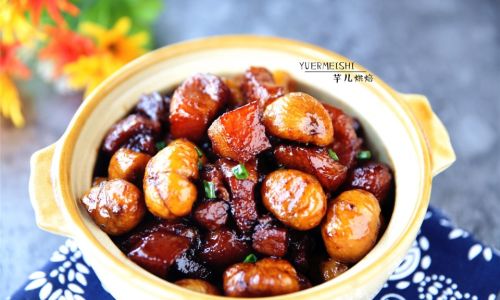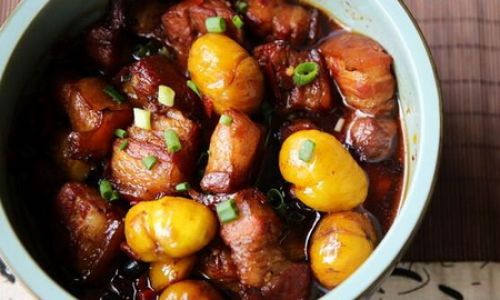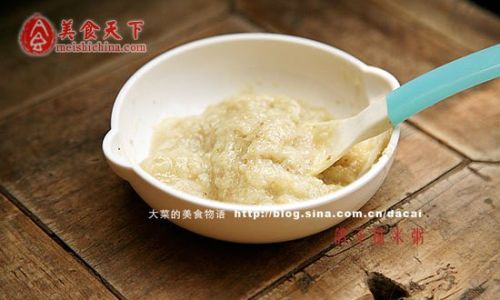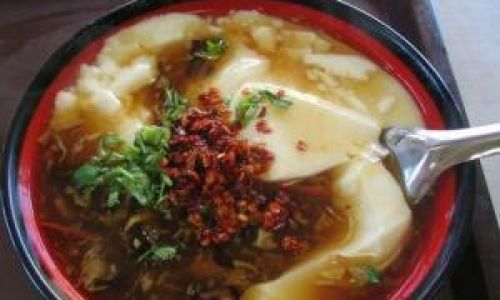Introduction
In the realm of traditional Chinese cuisine, steamed dishes often hold a special place, embodying the essence of simplicity and harmony in flavor. Among these, “Steamed Pork Belly with Chestnuts” stands out as a timeless classic, combining the rich, succulent taste of pork belly with the sweet, earthy aroma of chestnuts. This dish is not only a feast for the taste buds but also a testament to the art of balance in cooking, where fats and sugars intertwine to create a symphony of flavors.
In this comprehensive guide, we will delve into the step-by-step process of preparing Steamed Pork Belly with Chestnuts, from selecting the freshest ingredients to mastering the steaming technique. Whether you are a seasoned chef or a home cook eager to explore new culinary territories, this recipe promises to be both an educational and delightful experience.
Section 1: Ingredient Selection and Preparation
1 Pork Belly

The cornerstone of this dish is, undoubtedly, the pork belly. When choosing pork belly, look for meat that is well-marbled with fat, as this will ensure a juicy, tender texture once cooked. Ideally, opt for pork belly slices that are approximately 1-inch thick, as they will hold their shape better during steaming and provide an optimal ratio of meat to fat.
Before cooking, it is crucial to thoroughly clean the pork belly. Rinse it under cold running water to remove any impurities, then pat it dry using paper towels. This step is vital to prevent any unwanted flavors from affecting the final dish.
2 Chestnuts
Chestnuts are the unsung heroes of this recipe, adding a natural sweetness and a nutty texture that complements the pork belly perfectly. When selecting chestnuts, look for those that are firm, have a smooth outer shell, and are free from cracks or holes. Fresh chestnuts are preferable, but if unavailable, vacuum-packed, peeled chestnuts can be used as an alternative.
To prepare the chestnuts, score the outer shell with a sharp knife in a cross-shaped pattern. This will make it easier to peel once cooked. Boil the chestnuts in hot water for about 5-7 minutes, then drain and let them cool slightly. Peel off both the outer shell and the inner skin, which can be quite sticky. Once peeled, set the chestnuts aside.
3 Seasonings and Aromatics
The seasoning for this dish is minimalistic yet impactful, highlighting the natural flavors of the pork and chestnuts. Essential ingredients include:
- Light soy sauce: For a subtle, savory taste.
- Dark soy sauce: Adds color and a deeper, richer flavor.
- Shaoxing wine (or dry sherry as a substitute): Enhances the aroma and brings out the umami in the pork.
- Rock sugar: Provides a hint of sweetness that balances the savory elements.
- Ginger and garlic: Essential for their aromatic properties, helping to neutralize any gamey flavors in the pork.
- Star anise and Sichuan peppercorns: These spices add complexity and depth to the dish.
Section 2: Marinating the Pork Belly

Marinating the pork belly is a crucial step that ensures it absorbs all the flavors before steaming. In a large bowl, combine the following ingredients:
- 3 tablespoons of light soy sauce
- 1 tablespoon of dark soy sauce
- 2 tablespoons of Shaoxing wine
- 1 tablespoon of finely chopped ginger
- 2 cloves of garlic, minced
- 1 piece of rock sugar (about 1 inch in diameter), crushed
- 1 star anise, broken into pieces
- A pinch of Sichuan peppercorns, lightly toasted and crushed
Mix these ingredients well until the sugar is fully dissolved. Add the pork belly slices to the marinade, ensuring each piece is evenly coated. Cover the bowl with plastic wrap or transfer to a zip-top bag and marinate in the refrigerator for at least 2 hours, preferably overnight for maximum flavor infusion.
Section 3: Preparing the Steaming Dish
Once the pork belly has marinated sufficiently, it’s time to assemble the steaming dish. Begin by laying out a layer of peeled chestnuts at the bottom of a heatproof steaming dish. This layer will absorb the juices from the pork belly and infuse its own flavor into the dish.
Arrange the marinated pork belly slices over the chestnuts, making sure they are not overcrowded. This allows for even steaming and ensures that each piece of pork can cook through without being too dense. Pour the remaining marinade over the pork belly, ensuring all pieces are well-moistened.
Section 4: The Art of Steaming
Steaming is a gentle cooking method that preserves the natural juices and flavors of the ingredients. It requires patience and attention to detail to achieve perfection.
1 Setting Up the Steamer

Fill a large pot or wok with enough water to reach just below the steaming rack. Bring the water to a rolling boil over high heat. Place the steaming dish containing the pork belly and chestnuts on the rack, cover the pot tightly, and reduce the heat to maintain a steady, gentle simmer.
2 Steaming Time
The steaming time for Steamed Pork Belly with Chestnuts typically ranges from 1.5 to 2 hours, depending on the thickness of the pork belly and the desired doneness. It is crucial not to rush this process, as the slow, gentle heat allows the pork to become tender and flavorful, while the chestnuts retain their shape and texture.
During the steaming process, avoid opening the lid frequently, as this can release steam and disrupt the cooking temperature. If necessary, check the water level in the pot periodically to prevent it from drying out.
Section 5: Finishing Touches
Once the steaming time is up, carefully remove the steaming dish from the pot using oven mitts or tongs. Let it rest for about 10 minutes before serving, as this allows the juices to redistribute within the meat, making it even more tender and flavorful.
1 Garnishing
For an added touch of elegance and flavor, garnish the dish with a sprinkle of chopped green onions or scallions, and a drizzle of sesame oil. This not only enhances the visual appeal but also adds a fresh, aromatic note to the dish.

2 Serving Suggestions
Steamed Pork Belly with Chestnuts pairs beautifully with a variety of sides. Consider serving it with steamed rice to soak up the delicious juices, or with a side of pickled vegetables for a refreshing contrast. A light soy-vinegar dipping sauce can also be provided for those who prefer a bit more tang in their meal.
Conclusion
Steamed Pork Belly with Chestnuts is a dish that embodies the essence of Chinese culinary philosophy: simplicity, balance, and harmony. By carefully selecting and preparing the ingredients, marinating the pork belly to perfection, and mastering the art of steaming, you can create a meal that is not only visually stunning but also a delight for the senses.
This recipe is not just about following steps; it’s about understanding the why behind each action, from the choice of ingredients to the steaming technique. It invites you to slow down, appreciate the process, and savor the fruits of your labor.
As you sit down to enjoy this culinary masterpiece, take a moment to reflect on the journey that brought you to this moment. The aroma of the chestnuts mingling with the rich scent of the pork belly, the tender texture of each bite, and the harmonious blend of flavors will undoubtedly leave a lasting impression.
Remember, cooking is an art form that requires practice and patience. With each attempt, you will grow as a cook, discovering new nuances and refining your techniques. So, embrace the process, enjoy the journey, and let the magic of Steamed Pork Belly with Chestnuts inspire you to create even more delightful culinary adventures.






0 comments